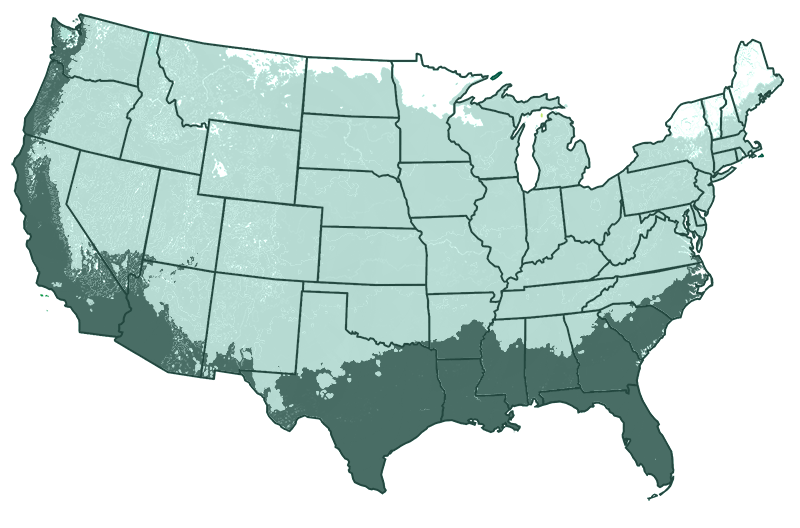


Cold Hardy Avocado Tree
View More Planting Info
Cold Hardy Avocado Trees perform best in a full sun position, at least 6+ hours per day. While they are considered thirsty trees, the soil should be well-draining to prevent root rot. When planting in containers, choose a high-quality potting mix that drains well. Dig a hole twice as wide and just as deep as the root ball. Gently remove the bush from its container, loosen the roots, and place it in the hole, ensuring the top of the root ball is level with the soil surface. Backfill the hole, gently tamping down the soil to remove air pockets. Water thoroughly after planting to settle the soil around the roots. Mulch around the base to retain moisture and regulate soil temperature.
Harvesting:
Harvest when fruits have reached a good size and the skin darkens slightly. Remove from the tree for full ripening.
Pruning:
Prune for shape. Remove dead wood and trim damaged or crossing branches. Heavy pruning can reduce fruit production.
Growth:
Hardy Avocado reaches 8 feet in containers and up to 10 feet in the ground. Space at least 10 feet away from other plants.
- Product Info
- Care and Maintenance
- Planting Care
- Growing Zone
Product Info
Mature Height: 8-10 ft.
Mature Width: 4-6 ft.
Sunlight: Full-Part Sun
Growth Rate: Fast
Does Not Ship To: AZ, OR
Care and Maintenance
Watering: Watering needs vary based on soil type, weather conditions, and planting position (in the ground or in containers). Young trees need watering 2-3 times a week, while established trees may need weekly watering or less, depending on rainfall. Water deeply to encourage deep root growth, allowing the soil to dry slightly between waterings. Water potted avocados more often to stop the soil from drying out completely.
Fertilizing: For newly planted trees, apply a balanced fertilizer once every 4-6 weeks from spring to fall. Once established, switch to a slow-release, nitrogen-rich fertilizer applied once in the early spring and again in late summer. Adjust based on the tree's growth and fruit production, observing for signs of nutrient deficiency.
Pruning: Avocado trees don’t require much pruning. Prune in early spring to shape the tree and remove dead wood. Also trim any branches that are damaged or crossing. Avoid heavy pruning as this can reduce fruit production.
Pests and Diseases: Cold Hardy Avocado Trees are not majorly prone to pest problems. Monitor for pests like fruit flies, avocado thrips, scale insects, and mites that damage the foliage and fruits. Root rot is a common disease in avocados, managed by planting in well-draining soil and avoiding overwatering.
Pollination: Cold Hardy Avocado Trees are self-pollinating. However, planting another avocado tree nearby for cross-pollination will improve the fruiting of both trees.
Harvesting: Avocados are ready to harvest when they slightly change color and have grown in size. Harvest by cutting the fruit from the tree with pruning shears, leaving a short stem attached. Handle gently to avoid bruising. After harvesting, place avocados at room temperature until they yield to gentle pressure, indicating ripeness.
Recovery Time: Transitioning from our nursery to your home can be a bit of a shock to your plant. A short acclimation period helps it recover and reduces stress.
How to Acclimate Your Plant: Keep the plant in its container and place it in a shady, sheltered area away from high winds. Ensure it's watered adequately – the soil should be moist but not waterlogged. Monitor the plant for any signs of distress and allow it to adjust for a few days before planting. After a few days of acclimation, your plant will be better prepared to thrive in its new home for years to come.
Planting Care
Sunlight: Plant in full sun, providing at least 6 hours of direct sunlight per day. They can tolerate partial sun, although yield will be impacted.
Soil: Plant in rich, well-draining soil amended with compost. In containers, choose a well-draining potting mix to prevent rot.
Mature size: These trees grow to around 8 feet in containers and up to 10 feet in the ground.
Climate: While these trees are hardier than other avocados, they do grow best in warmer climates, suitable for USDA Zones 8b-11. Those in cooler climates can keep them indoors or in a greenhouse over winter.
Thinning: Remove damaged or diseased branches to improve growth and any branches that are crossing one another.
Location: Plant in a sunny position in well-draining soil, either in containers or outdoors in the ground in warmer regions.
Watering: Water the tree every few days after planting and around once per week once established, allowing the soil to dry out slightly between waterings. Reduce frequency in winter and periods of rainfall.
Pruning: Prune in early spring to shape the tree and remove dead wood. Avoid heavy pruning as this can reduce fruit production.
Spacing: Plant at least 10 feet away from any other trees or nearby structures in your garden.
Harvesting: Harvest when the fruits have reached a good size and the skin darkens slightly. Trim off the tree gently rather than pulling to avoid bruising.
Pollination: Avocado trees are self-fertile but benefit from cross-pollination. Consider planting a second tree for better fruit set.
Hardiness Zone: Cold Hardy Avocado Trees are suitable for planting in USDA Zones 8b-11.
Fertilizer: Once established, feed once per season in spring and summer with a slow-release fertilizer slightly higher in nitrogen.
Growing Zone
Grows Well In Zones: 4-11 patio / 8-11 outdoors





